Scooping International News While Empowering Women: Global Press Institute
Categorized as: Africa, Asia, Caribbean, Education, Girls & women, Grantee, Job Creation, Latin America, Leadership, Our Partners, Pacific Islands, Poverty Alleviation, Stories, Storytelling & Tagged as: Cristi Hegranes, Huffington Post, Journalism, Social entrepreneurism on January 10, 2015.
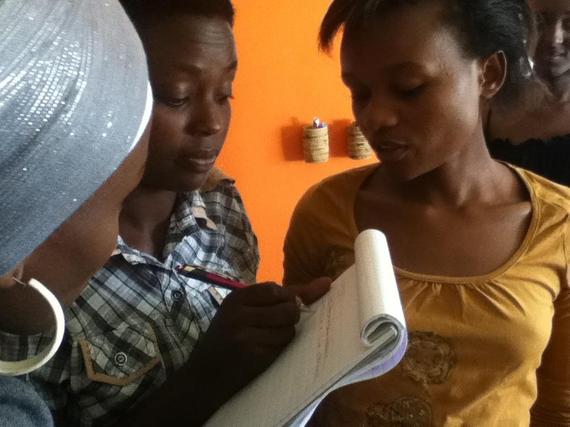
Once upon a time, a young American woman landed her dream job — and then gave it to someone else. Ten years later, she’s creating a sustainable new model for international journalism that provides jobs and empowers women all over the world.
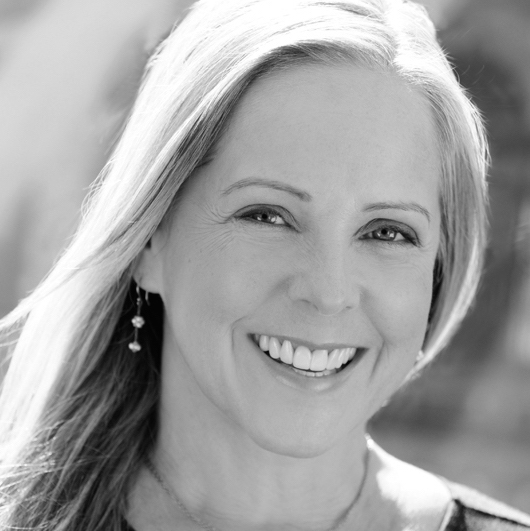 By Suzanne Skees for Huffington Post.
By Suzanne Skees for Huffington Post. ![]()
Click here to read the original version.
How a Social Enterprise Startup Became a Major Media Outlet
This is a story about stories: Once upon a time, a young American journalist named Cristi Hegranes found herself living her dream job as a foreign correspondent in Nepal. Writing and filing articles, she realized that she could never really get it right.
“As an outsider, I could never report the news with the same level of authenticity and cultural sensitivity as someone who grew up there,” Cristi says. “That’s when I realized that I had the model for Global Press Institute.”
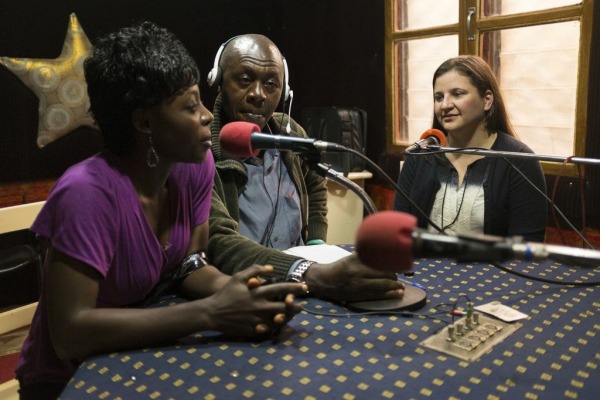 Cristi (R) looks on as a GPI journalist gives a radio interview.
Cristi (R) looks on as a GPI journalist gives a radio interview.
Cristi came home to the U.S. and in 2006, launched her mission to bring “the three E’s: educate, employ, and empower” to indigenous women journalists from Nepal to Haiti to Cameroon. What she didn’t foresee was that as a social entrepreneur, she’d develop an “intimate relationship with spreadsheets and fundraising,” camping out at her San Francisco office, and described the long flights to countries where she’d train others to tell their own stories as “relaxing”. Cristi was just beginning to log hours and miles far beyond her imagination.
“I take [my] commitment to employ these women extremely seriously,” Cristi says. When the days begin long before dawn, on Skype calls with news bureaus around the world, and end long after her shoulders have knotted up in pain, “It just takes a quick memory to think back to time I’ve spent with our journalists, at our news desks around the world — and that is an instant push to just keep going.”
Impact of Global Press Institute Today
Today, GPI employs 159 women in 25 developing countries. Five million readers rely on GPI’s news features in 160 countries. Utilizing a subscription model of content-delivery marketing, GPI launched the Global Press News Service last year. GPNS is helping GPI to graduate from grants and become a self-sustaining social enterprise. Already, revenues from syndication are coming in from 64 partners, including Al Jazeera America, United Press International, and Reuters.
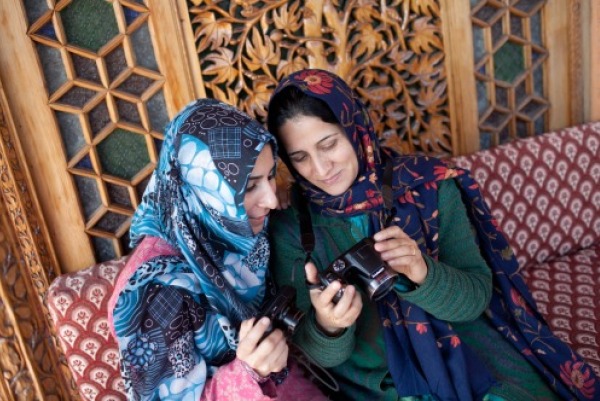 GPI reporters train in video and photography to become multimedia storytellers.
GPI reporters train in video and photography to become multimedia storytellers.
This is a new way forward in the field of international journalism. While legacy news organizations have slashed budgets, leaving 60 percent fewer journalists to cover international news, GPI operates on two percent of their budget by training reporters in-country to cover news and social issues in quality, long-form features that have garnered attention from Ashoka and the Clinton Global Initiative (CGI), among others. The reporters of GPI have won numerous journalism awards including the Kurt Schork Prize for International Journalism, the Journalism Innovation Prize from the Society of Professional Journalists, the Ida B. Wells Award for Bravery in Journalism and the Ulrich Wickert Award for Child Rights.
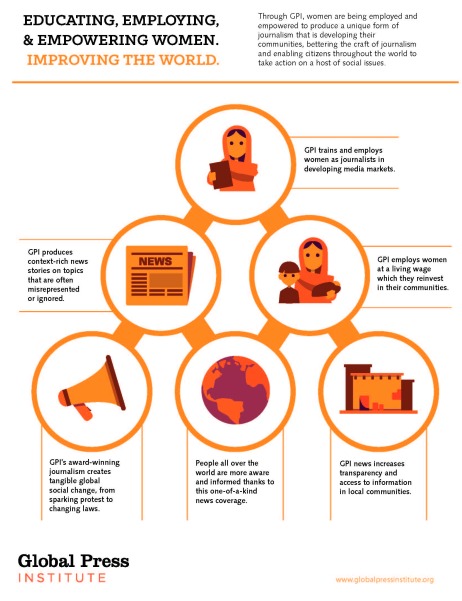
What Makes GPI Different from Other News Media
Global Press Institute comprises three entities working in unison to create jobs and stories:
1. Global Press Institute: Offers an intensive training program to local women in developing media markets who have no prior experience in journalism.
2. Global Press Journal: Employs 100 percent of GPI’s training graduates to work at a local news desk writing for the Global Press Journal. Reporters work within a sophisticated editorial structure that includes editors, copy editors, fact checkers and story coaches. The Journal features award-winning news coverage on social, climate, and political issues around the world. Articles on:
- Arts and culture
- Business
- Community
- Education
- Environment
- Gender justice
- Health
- Politics
3. Global Press News Service: Offers Global Press Journal content and additional content to a network of media, education and corporate syndication partners. The News Service drives revenue back into the Institute to create more trainings and more news production. Local language versions of the content are offered for free to a network of partners in the communities where GPI operates.
The brilliance of GPI is its content: rich, high caliber news and features written by cultural insiders. Brave, talented GPI reporters come from underprivileged, underrepresented communities in 25 developing countries. Journalists include members of the untouchable caste in Asia, former sex workers in Africa and indigenous women in Latin America. Others have formal education and work experience, but live in communities where middle class employment and leadership opportunities for women are rare.
GPI has found that women reinvest up to 90 percent of earnings back into family and community.
The Economic Model for News Is Broken
In their own words — from Global Press Institute’s industry research:
The economic model is broken. According to the Nieman Foundation for Journalism at Harvard, “a single foreign correspondent costs a newspaper around $250,000 a year.” As a result, over the past 25 years, more than 60 percent of all foreign bureaus have been closed and foreign news in daily newspapers has declined by 53 percent. GPI fills this void at less than 2 percent of the cost.
Women are underrepresented in the news. According to the Global Media Monitoring Project, for every woman who appears in the news, there are five men. Accordingly, women’s voices are rarely heard on the topics that dominate the news agenda, and women are rarely featured in news stories as authorities or experts. GPI helps correct this imbalance by training and employing female journalists.
Most news agencies are missing the real stories. According to a study by Routledge Media, 97 percent of international news coverage is focused on just four topics: war, natural disaster, poverty, and disease. GPI journalists report on issues in their communities that are often ignored by other news media, such as health, arts and culture, and entrepreneurship.
Global Press Institute covers such fearless topics as:
- As Women Become Aware of Right, Divorce Rates Double in Nepal
- Zambian Girls Stretch Labia to Avoid Infidelity
- Low-Quality Medicine and Patients’ Rights Violations Plague Sri Lanka
- Tattoo Culture Shifts from Rebellion to Fashion at Argentine Convention
- Music Therapy Helps Autistic Children Find Their Voices in Nepal
- Women Use Natural Resources to Escape Poverty in Botswana
- Despite Reprisals, Kenyan Cleric Welcomes Gays and Lesbians
Global Press Institute uses journalism a development tool by:
- Producing award-winning news that sparks social change
- Addressing issues overlooked by mainstream media
- Bringing transparency and attention to social issues
- Empowering reporters to give voice to their communities
- Creating global awareness of our shared human condition (issues like clean water, motherhood, and food security), which increases tolerance, justice, and peace.
Global Press Institute by the Numbers:
- 159 women
- 25 news bureaus in developing media markets
- 41 journalists received advanced technology training
- 98 percent of GPI’s journalists report feeling empowered as a result of their work
The Contagion of Giving Away Jobs
GPI’s senior training strategist Maura Bouge writes about a moment when she, an American, encountered the new regional editor for GPJ Africa, Wairimu Michengi, in Nairobi, Kenya.
As Wairimu trained for her new position, she was already planning on a promotion to Maura’s old job — managing editor. Instead of feeling threatened, Maura was elated. True to Global Press Institute’s mission to empower local women rather than the Americans back at headquarters, Maura writes:
Our lofty organizational mission to empower, educate and employ women around the world to tell local stories with the potential to spark social change became as real as the intense, brown eyes staring back at me.
I responded that she would make a fantastic managing editor one day. And I genuinely hoped she would. Her taking my job would mean that I had done my job well.
Previously, U.S. staff edited reporters’ submissions… but they’ve realized that a local eye can see cultural nuances we’d never understand back home. Maura’s next move will be to replace herself again–by hiring training strategists from each geographic region rather than importing them from the U.S. The result is an authenticity of journalistic voice that you just don’t achieve with foreign correspondents, no matter how long they’ve toiled in-country.
Rarely the case with nonprofits, Global Press Institute intends to evolve into a self-sustaining social enterprise with enough revenue from syndication to pay reporters’ salaries and keep the lights on in their increasing numbers of offices around the world. We believe they can and will accomplish this feat — and soon.
Photographs (c) Paige Stoyer for Global Press Institute.
LEARN more about Global Press Institute here.
SHARE this story on Facebook and Twitter; see menu at top and bottom of page.
DONATE directly to Global Press Institute here.
SUBSCRIBE! Like what you see? Click here to subscribe to Seeds of Hope!
